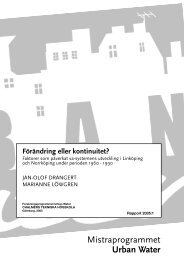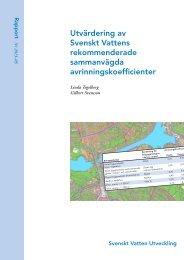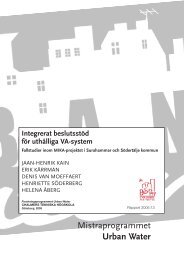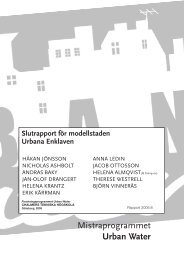utvärdering av en syntesstrategi för uthålliga VA-system - Urban Water
utvärdering av en syntesstrategi för uthålliga VA-system - Urban Water
utvärdering av en syntesstrategi för uthålliga VA-system - Urban Water
Create successful ePaper yourself
Turn your PDF publications into a flip-book with our unique Google optimized e-Paper software.
fer<strong>en</strong>t mathematical models for processing data and weighting criteria –<br />
more or less in dialogue with stakeholders. Deterministic distance-to-target<br />
procedures although, do h<strong>av</strong>e the disadvantage of being in need of a<br />
defined target, a definition which is seldom done in immediate cons<strong>en</strong>sus<br />
and sometimes impossible to reach since the estimations are time and place<br />
dep<strong>en</strong>d<strong>en</strong>t. For non-deterministic situations, like this case, the target<br />
was not defined and the criteria to process were both of a quantitative and<br />
qualitative nature.<br />
The approach for the sociocultural criteria was for instance not an impact<br />
assessm<strong>en</strong>t, but a methodology for id<strong>en</strong>tification of crucial sociocultural<br />
aspects to consider for sustainable urban water <strong>system</strong>s. Sociocultural<br />
criteria h<strong>av</strong>e mainly in previous research be<strong>en</strong> addressed through<br />
social impact assessm<strong>en</strong>t emphasising only one–way influ<strong>en</strong>ces on the<br />
social spheres by the technical structure. However, since the sub-<strong>system</strong>s<br />
“technology”, “users” and “organisations” within the total urban water<br />
<strong>system</strong> are mutually affecting each other, the relationships betwe<strong>en</strong> these<br />
sub-<strong>system</strong>s h<strong>av</strong>e to be described and analysed.<br />
Environm<strong>en</strong>t and hygi<strong>en</strong>e were treated as impacts. Technical function<br />
did not include impacts at all, but focused on frequ<strong>en</strong>cy estimations for<br />
differ<strong>en</strong>t disturbances to occur. The economy was a straightforward budget<br />
including investm<strong>en</strong>t costs and costs for operation and maint<strong>en</strong>ance.<br />
The prerequisites for choosing a multicriteria method able to cope with<br />
the chall<strong>en</strong>ges were demanding. Together with the complicated combination<br />
of criteria, the researchers in the program already took a set of critical<br />
decisions wh<strong>en</strong> two <strong>system</strong> structures were designed together with relevant<br />
criteria before this project started. More process-ori<strong>en</strong>ted methods<br />
were thereby not possible. Other factors to consider were the sophistication<br />
of the workshop participants (which were high here), the time allocated<br />
to the workshop (six hours), the number of alternatives to be considered,<br />
and the way in which we expected the participants to be comfortable<br />
expressing their prefer<strong>en</strong>ces.<br />
The method finally used at the workshop was the Regime method, an<br />
outranking method able to give indications of which alternatives are preferred<br />
to others and whether it is impossible to distinguish a prefer<strong>en</strong>ce<br />
betwe<strong>en</strong> the alternatives at hand. The Regime method is software where<br />
alternatives are compared through a pair-wise comparison for each criterion.<br />
A tool that can be described as a temperature scale was used for weighting<br />
the criteria. This approach was used to provide a possibility to get<br />
reactions from the groups on such a working procedure, and it also provided<br />
analysing possibilities by use of the Yakowitz multiattribute tool.<br />
E<strong>VA</strong>LUATION CRITERIA<br />
Multicriteria procedures aim at support and structure complex planning<br />
and decision-making situations. Since this was no deterministic problem<br />
one of the most important pieces of evid<strong>en</strong>ce of a good approach is that<br />
the stakeholders are satisfied with both the process and the outcome. Another<br />
important piece of evid<strong>en</strong>ce is satisfaction among the researches<br />
VII








